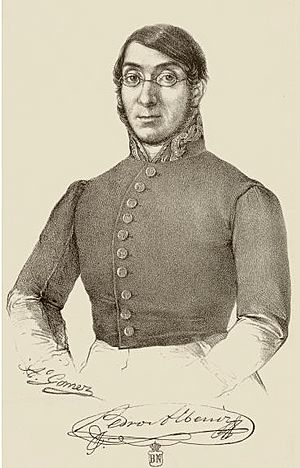Pedro Albéniz facts for kids
Quick facts for kids
Pedro Albéniz y Basanta
|
|
|---|---|
 |
|
| Born |
Pedro Pérez de Albéniz y Basanta
14 April 1795 |
| Died | 12 April 1855 (aged 59) |
Pedro Albéniz y Basanta (April 14, 1795 – April 12, 1855) was a talented Spanish pianist and composer. He was a very important musician in Spain during his time. It's good to know that he was not related to the famous composer Isaac Albéniz.
Contents
Life of Pedro Albéniz
Pedro Albéniz was born in Logroño, a city in La Rioja, Spain. He started learning music from his father, Mateo Albéniz, who was also a well-known church musician.
To continue his musical journey, Pedro went to Paris, France. There, he studied with some of the best music teachers. He even received helpful advice from the famous composer Gioachino Rossini.
In 1830, Pedro returned to Spain. He became the organist at the Church of Santa María in San Sebastián. Later, he moved to Madrid and became a professor at the Madrid Royal Conservatory, a very important music school. He also played the organ at the Capilla Real (Royal Chapel). One of his most special jobs was being the personal piano teacher for Queen Isabella II of Spain! He passed away in Madrid.
As he got older, Pedro focused less on performing concerts. Instead, he dedicated his time to teaching music. He wrote many pieces for piano, as well as chamber music and songs. However, he is best remembered for his special piano method (a teaching book). All Spanish pianists at the Madrid Conservatory used his method to learn piano during the mid-1800s.
Pedro Albéniz's Compositions
Pedro Albéniz wrote many different kinds of music. Here are some examples of his works:
Music for Concert Bands
He composed pieces for concert bands, which are groups of musicians playing instruments like trumpets, clarinets, and drums.
- Himno (Hymn) – written for a celebration in San Sebastián.
- Marcha e himno (March and Hymn) – created for a special event involving the Princess of Asturias.
- Marcha triunfal (Triumphal March) – performed during a carnival celebration in San Sebastián.
Choral Music
Pedro also wrote music for choirs, which are groups of singers. These pieces often included solo singers and piano accompaniment.
- He wrote several Villancico real al nacimiento de N.S. Jesucristo (Royal Carols for the Birth of Our Lord Jesus Christ). These were often for different combinations of voices, like soloists, children's choirs, or mixed choirs.
Piano Works
Pedro Albéniz composed many pieces specifically for the piano. These show his skill as a pianist and his creativity.
- Rondó brillante a la tirana – a lively piano piece.
- Variaciones brillantes sobre el "Himno de Riego" – a set of bright variations on a popular Spanish hymn.
- Fantasía elegante sobre motivos escogidos de la ópera "I puritani" – a fancy piece based on tunes from an opera by Vincenzo Bellini.
- Vals no.4 and Vals no.5 – two waltzes for piano.
- Lucia di Lammermoor – a fantasy piece using themes from a famous opera by Verdi.
- Corona musical de canciones populares españolas – a collection of popular Spanish songs arranged for piano.
- 12 estudios melódicos para piano á cuatro manos – 12 melodic studies for two pianists playing on one piano, written for Queen Isabella II.
- He also wrote several "characteristic Spanish music" pieces, like El chiste de Málaga (The Joke of Málaga) and El polo nuevo (The New Polo).
- Many of his fantasies were based on themes from operas by Giuseppe Verdi, such as Nabucco, Attila, Ernani, and I Lombardi. Some of these were for two pianos or for four hands (two players on one piano).
- Flores melódicas (Melodic Flowers) and Mi Delicia (My Delight) are other examples of his piano works.
See also
 In Spanish: Pedro Albéniz para niños
In Spanish: Pedro Albéniz para niños

